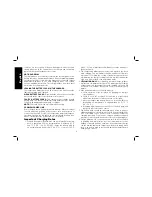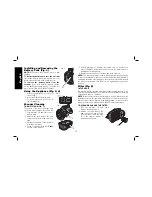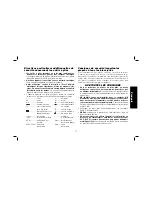
• Use safety equipment. Always wear eye protection.
Dust mask,
non-skid safety shoes, hard hat, or hearing protection must be
used for appropriate conditions.
• Use extra care when cleaning on stairs.
• Do
not
use without filter in place.
• Do not use the appliance to pick up flammable or combustible
liquids, such as gasoline, or use in areas where flammable or
combustible liquids are present.
• Do not
pick up anything that is burning or smoking, such as
cigarettes, matches or hot ashes.
• Do
not
use in areas where explosive vapors may be present.
• Do
not
use to pick up explosive dust, or in areas where air contains
explosive dust such as coal, grain, or other combustible material.
• Static shocks are possible in dry areas or when the relative humidity
of the air is low. This is only temporary and does not affect the use
of the vacuum. To reduce the frequency of static shocks, add
moisture to the air with a console or installed humidifier.
• To avoid spontaneous combustion, empty canister after each use.
• Store idle tools.
When not in use, the vacuum should be stored in
a dry, high or locked up place – out of the reach of children.
•
Disconnect the battery pack from the vacuum before making any
adjustments, changing accessories, servicing, moving or storing
the vacuum.
Such preventative safety measures reduce the risk of
starting the appliance accidentally.
• Avoid accidental starting.
Be sure the switch is in the OFF position
before inserting the battery pack.
•
Never leave vacuum running unattended. Turn power off.
• Keep your work area clean and well lit.
Cluttered benches and dark
areas invite accidents.
•
Do not overreach. Keep proper footing and balance at all times.
Proper footing and balance enables better control of the vacuum
in unexpected situations.
• Do not use appliance if switch does not turn it on or off. Any
appliance that cannot be controlled with the switch is dangerous
and must be repaired.
• Turn off all controls before removing the battery pack.
SAVE THESE INSTRUCTIONS
ADDITIONAL SAFETY RULES
WARNING: When not in use, place vacuum on a stable
surface where it will not cause a tripping or falling hazard.
• Do not use vacuum as a step ladder.
• Do not place heavy objects on vacuum.
•
Air vents often cover moving parts and should be avoided.
Loose clothes, jewelry or long hair can be caught in moving parts.
WARNING: ALWAYS
use safety glasses. Everyday eyeglasses are
NOT safety glasses. Also use face or dust mask if cutting operation is
dusty. ALWAYS WEAR CERTIFIED SAFETY EQUIPMENT:
• ANSI Z87.1 eye protection (CAN/CSA Z94.3),
• ANSI S12.6 (S3.19) hearing protection,
• NIOSH/OSHA/MSHA respiratory protection.
WARNING:
Some dust created by power sanding, sawing,
grinding, drilling, and other construction activities contains chemicals
known to the State of California to cause cancer, birth defects or other
reproductive harm. Some examples of these chemicals are:
• lead from lead-based paints,
•
crystalline silica from bricks and cement and other masonry
products, and
• arsenic and chromium from chemically-treated lumber.
Your risk from these exposures varies, depending on how often you
do this type of work. To reduce your exposure to these chemicals:
work in a well ventilated area, and work with approved safety
English
2
Summary of Contents for DCV580
Page 2: ......





































